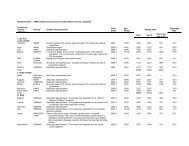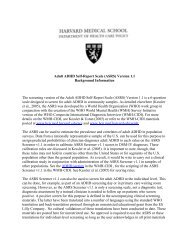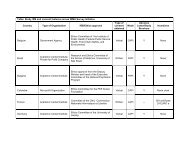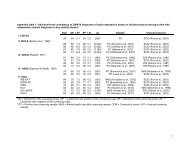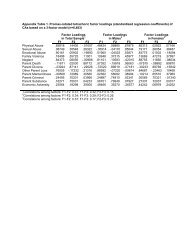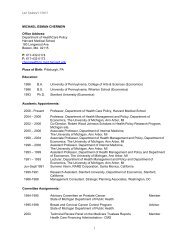Model Quality Report in Business Statistics - Harvard ...
Model Quality Report in Business Statistics - Harvard ...
Model Quality Report in Business Statistics - Harvard ...
Create successful ePaper yourself
Turn your PDF publications into a flip-book with our unique Google optimized e-Paper software.
where<br />
y<br />
R ˆ =<br />
h<br />
sh<br />
x<br />
sh<br />
( tˆ<br />
)<br />
( 1−<br />
f ) h 2<br />
2 2<br />
( S − 2Rˆ<br />
S Rˆ<br />
S )<br />
2<br />
ˆ N<br />
h<br />
V<br />
1 y,<br />
rat<br />
= ∑ ysh<br />
h xys<br />
+<br />
h h xs<br />
(4.7)<br />
h<br />
n<br />
h<br />
h<br />
, (that is, the stratified version of equation 6.11 <strong>in</strong> Cochran). An<br />
alternative variance estimator (see equations 6.12 and 6.13) is<br />
( tˆ<br />
)<br />
2<br />
( 1−<br />
f ) x<br />
h U h 2<br />
2 2<br />
( S − 2Rˆ<br />
S Rˆ<br />
S )<br />
2<br />
ˆ<br />
N<br />
h<br />
V<br />
2 y,<br />
rat<br />
= ∑ ysh<br />
h xys<br />
+<br />
h h xs<br />
(4.8)<br />
h<br />
n x<br />
h<br />
h<br />
2<br />
sh<br />
Note: (4.4) can be written<br />
∑∑<br />
t ˆ = w y where<br />
y,rat<br />
h<br />
sh<br />
h<br />
k<br />
txh<br />
w<br />
h<br />
= .<br />
x<br />
∑<br />
s<br />
h<br />
k<br />
4.3 What does SUDAAN do<br />
For stratified random sampl<strong>in</strong>g, the variance formula used is<br />
2 1<br />
where S<br />
zs<br />
= ∑( z − z )<br />
h<br />
k sh<br />
2<br />
( 1 f )<br />
Vˆ 2<br />
= ∑ − n S<br />
(4.9)<br />
nh<br />
−1<br />
sh<br />
variance formula corresponds to the design option DESIGN = STRWOR.<br />
h<br />
h<br />
h<br />
zsh<br />
, and z<br />
k<br />
is the “appropriate l<strong>in</strong>earised value”. Note that the<br />
So, if we want to estimate the variance of the usual expansion estimator (see (4.1)), we use<br />
DESCRIPT. The “l<strong>in</strong>earised value” is<br />
z = w y , and so long as<br />
k<br />
h<br />
k<br />
w<br />
N<br />
h<br />
h<br />
= (that is, the<br />
nh<br />
sampl<strong>in</strong>g weight), the variance formula <strong>in</strong> (4.9) gives the correct variance estimator of (4.3).<br />
What about the variance estimator for the ratio estimator def<strong>in</strong>ed <strong>in</strong> (4.4) Can SUDAAN be<br />
tricked by def<strong>in</strong><strong>in</strong>g the weight to be<br />
itself will be correct, but the variance formula <strong>in</strong> (4.9) with<br />
This is not the variance given <strong>in</strong> (4.7) or (4.8).<br />
w<br />
h<br />
=<br />
t<br />
∑<br />
xh<br />
sh<br />
x<br />
k<br />
2<br />
( − f ) xU<br />
h 2<br />
The answer is no. The ratio estimator<br />
2<br />
sh<br />
z<br />
t<br />
xh<br />
k<br />
= wh<br />
yk<br />
= yk<br />
will give<br />
∑ x<br />
s k<br />
h<br />
ˆ<br />
N<br />
2 h<br />
1<br />
h<br />
V = ∑<br />
S<br />
ys<br />
(4.10)<br />
h<br />
n x<br />
h<br />
h<br />
The answer is to use the RATIO procedure. In general, we can estimate the ratio for any<br />
subgroup d as<br />
Rˆ<br />
d<br />
=<br />
∑∑<br />
h<br />
∑∑<br />
h<br />
s<br />
s<br />
h<br />
h<br />
δ ( d)<br />
w y<br />
hk<br />
hk<br />
h<br />
δ ( d)<br />
w x<br />
h<br />
k<br />
k<br />
(4.11)<br />
34




